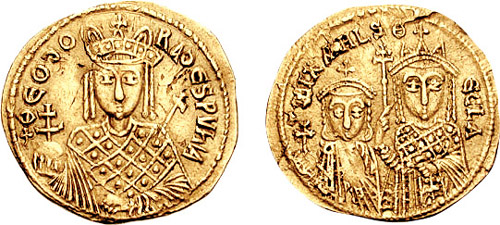
Empress Theodora on a gold coin, with her son and daughter on the other side.
With Theophilus dead, in 842 AD the Empire again had a woman in charge. The empress Theodora, at 27, became regent for her two-year-old son, Michael. Theodora was an iconodule. She allowed artists to make icons again. But she was smarter than Irene, and went slowly and carefully, and there were no riots. Theodora ruled peacefully for fourteen years.

A Viking ship
But when Michael was sixteen, in 856, Theodora’s brother Bardas led a coup (pronounced COO) against her. He placed Theodora’s son Michael III – Bardas’ nephew – on the throne. Bardas held the real power though. He won several battles against the Abbasid Caliphs. Theodora, who was now 41 years old, retired to a monastery.
Then in 860, a new and unexpected enemy appeared just outside Constantinople. Two hundred Russian ships showed up, probably sailed by Vikings emigrating from Scandinavia. The Russians and Vikings couldn’t get past the walls of Constantinople. They sailed back north after burning and pillaging everything outside the walls (including a lot of monasteries). But this was only the beginning of battles with Russia, and only the beginning of Viking raids on West Asia.
In 866, this dynasty came to a sudden end thanks to a guy named Basil. Basil was a friend of Michael’s who had just been promoted from being an illiterate peasant soldier who was good with horses. Basil first killed Bardas, and then a few months later, in 867, also killed Michael. So Basil became the next emperor.
Learn by doing: visit a Russian orthodox church
More about Basil
Bibliography and further reading about Byzantine history: